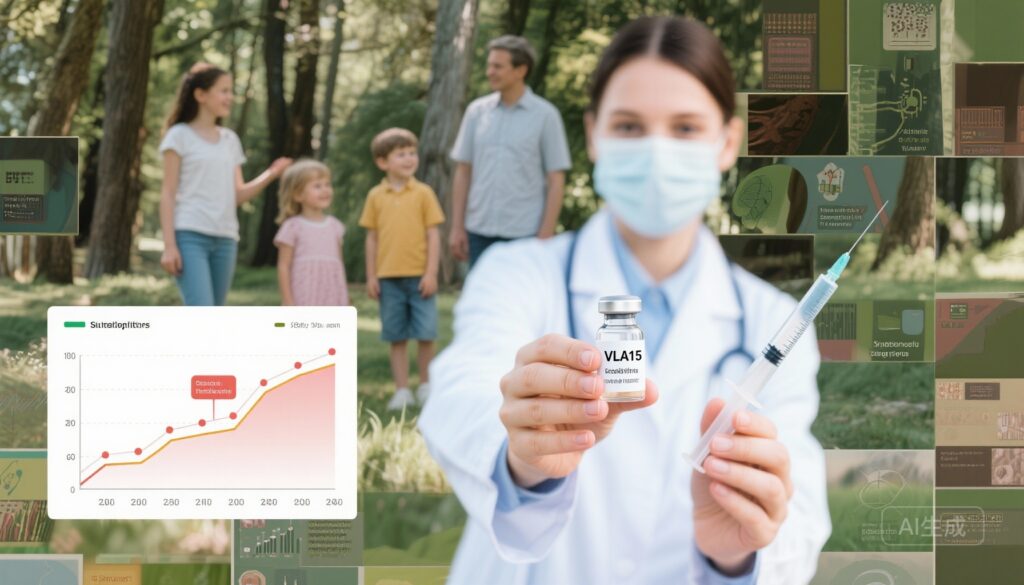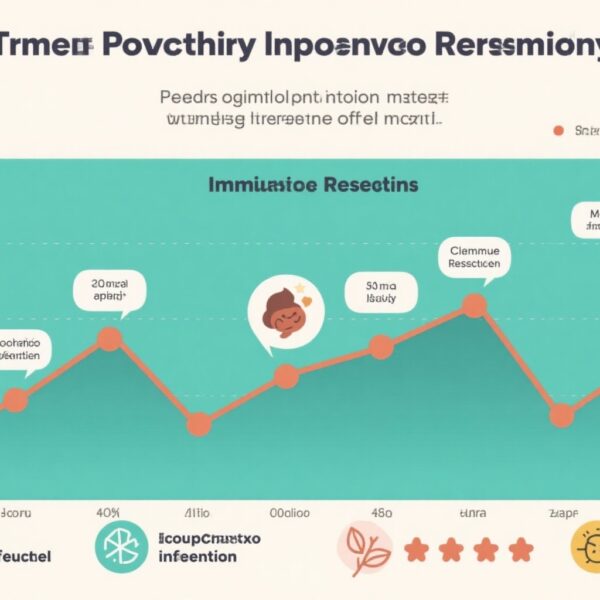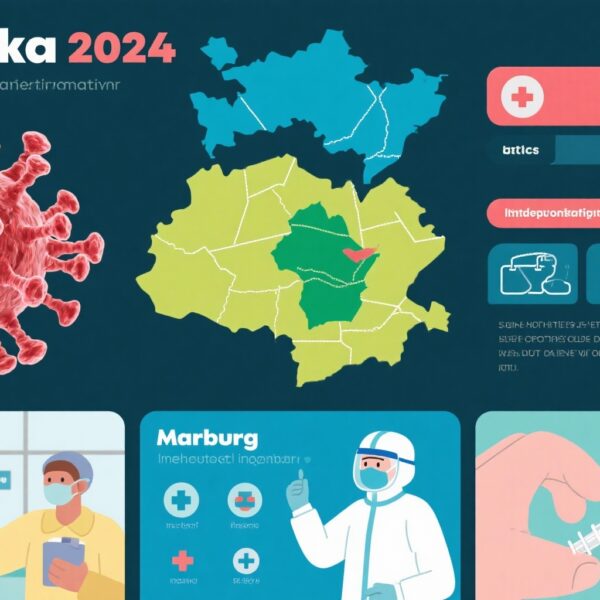Highlights
– An 18‑month booster of VLA15 increased OspA serotype‑specific IgG geometric mean titres (GMTs) above levels achieved after the primary series in children (5–11 y), adolescents (12–17 y), and adults (18–65 y).
– Paediatric cohorts showed higher post‑booster GMTs than adults, consistent with stronger vaccine responses in younger age groups.
– The month‑18 booster had a tolerability profile comparable to primary doses; unsolicited adverse events within 1 month were uncommon and self‑limited.
Background
Lyme borreliosis (Lyme disease), caused by Borrelia species transmitted by Ixodes ticks, is the most common tick‑borne infection in temperate regions of the northern hemisphere. In the United States, reported cases exceed 30,000 annually, with estimates of under‑reporting indicating a substantially larger burden. Clinical manifestations range from erythema migrans and flu‑like illness to neurologic, cardiac, and arthritic complications when diagnosis or treatment is delayed. Preventive strategies have relied on avoidance, tick checks, and prompt antibiotic therapy; however, a safe and effective human vaccine could transform prevention, particularly for children who have high exposure during outdoor activities.
Study design
The report by Wagner et al. presents month‑19 immunogenicity and safety data from an ongoing randomised, observer‑blind, placebo‑controlled phase 2 trial (ClinicalTrials.gov NCT04801420) conducted at 14 centres in Lyme‑endemic areas of the USA. Healthy participants aged 5–65 years were enrolled into three age cohorts (5–11, 12–17, and 18–65 years) and randomised within each cohort 1:1:1 to receive either:
- VLA15 at months 0, 2, and 6 (M0‑2‑6),
- VLA15 at months 0 and 6 with placebo at month 2 (M0‑6), or
- Placebo at months 0, 2, and 6.
At month 18, participants in both VLA15 groups received a VLA15 booster (forming M0‑2‑6‑18 and M0‑6‑18 groups); the original placebo group received placebo at month 18. The month‑18 booster analysis reported here includes data up to month 19. Key secondary endpoints included OspA serotype‑specific IgG GMTs (per‑protocol) and solicited/unsolicited adverse events (safety set) from month 18 to 19.
Key findings
Population and follow‑up: 625 participants were randomised and received at least one vaccination. The month‑18 booster was administered to 449 participants between Sept 21, 2022, and Jan 24, 2023. Of 513 participants in the per‑protocol set, 398 received the booster and 394 completed the month‑19 visit.
Immunogenicity
After the primary series, OspA‑specific IgG GMTs declined through month 18 in both VLA15 groups. One month after the month‑18 booster, GMTs rose substantially and exceeded titres observed after the primary series. Reported post‑booster GMT ranges in the overall population included:
- M0‑2‑6‑18 group: serotype 1 GMT 1057.0 U/mL (95% CI 843.1–1325.1) to serotype 2 GMT 1807.9 U/mL (1486.2–2199.3).
- M0‑6‑18 group: serotype 1 GMT 830.0 U/mL (95% CI 621.3–1108.9) to serotype 2 GMT 1603.1 U/mL (1239.7–2073.0).
Across age groups, paediatric participants demonstrated higher post‑booster GMTs than adults — a reproducible observation consistent with stronger humoral responses in children following primary vaccination. The robust anamnestic response indicates effective immunological priming by the primary series and strong boostability at 18 months.
Clinical and statistical considerations
The reported increases in GMTs were large and consistent across OspA serotypes tested. The study provides precise GMT estimates with 95% confidence intervals, supporting statistical robustness of the measured humoral response. It is important to note that this phase 2 trial evaluated immunogenicity and safety rather than clinical efficacy against laboratory‑confirmed Lyme disease; antibody titres to OspA are used as a biologically plausible surrogate given earlier vaccine experience linking anti‑OspA responses to protection.
Safety
Tolerability of the month‑18 booster was similar to that of primary doses and consistent across age cohorts. Within 1 month after the booster, related unsolicited adverse events were reported in four (1%) of 302 VLA15 booster recipients and three (2%) of 147 placebo recipients; all resolved without sequelae. There were no vaccine‑related unsolicited serious adverse events, adverse events of special interest, or deaths reported up to month 19. Events that led to trial withdrawal or serious unsolicited events were judged unrelated to vaccination and occurred before the month‑18 booster.
Expert commentary and context
Historical context: OspA‑based vaccination is not a new concept. The first licensed Lyme vaccine (LYMErix) used OspA and demonstrated efficacy; however, it was withdrawn from the market in the early 2000s for non‑scientific reasons related to low public uptake and safety concerns raised in litigation, despite limited evidence of causation. Renewed efforts with modern platforms and rigorous trials are scientifically justified given the persistent disease burden.
Biological plausibility
VLA15 targets OspA, an antigen expressed by Borrelia in the tick midgut. Anti‑OspA antibodies are thought to act within the tick during blood feeding, preventing spirochete transmission. The strong post‑booster rise in anti‑OspA IgG is therefore biologically plausible as a correlate of reduced transmission risk, though definitive correlates of protection in humans are still inferred from immunogenicity and prior vaccine efficacy studies.
Strengths
- Randomised, observer‑blind, placebo‑controlled design and well‑defined age cohorts.
- Robust immunogenicity assays reporting serotype‑specific GMTs with confidence intervals.
- Inclusion of paediatric participants down to age 5 — important for public health impact.
Limitations
- The trial reports immunogenicity and short‑term safety; it is not designed to measure clinical efficacy against Lyme disease.
- Follow‑up to month 19 captures only short‑term post‑booster responses; longer follow‑up is required to characterize persistence and the need for annual boosters.
- Participant demographics show limited racial diversity (85% White), which may affect generalisability.
- The study was conducted in US endemic areas; responses could differ in other geographic regions with varying Borrelia genospecies prevalence.
Clinical and public health implications
The observed boostability at month 18 supports a strategy of administering a VLA15 booster prior to or early in tick season to raise anti‑OspA antibody levels when exposure risk is highest. Higher titers in children suggest particular benefit for paediatric vaccination programs. However, policy decisions will require phase 3 efficacy data, long‑term persistence and booster schedules, and programmatic assessment including cost‑effectiveness and public acceptance.
Conclusion
In this phase 2 trial, an 18‑month booster of the VLA15 multivalent OspA vaccine candidate produced substantial anamnestic anti‑OspA IgG responses that exceeded primary‑series levels across age groups and was well tolerated. These data support further development of VLA15, including evaluation in larger phase 3 trials with clinical efficacy endpoints and longer follow‑up to define optimal booster timing and durability. Pending such data, a pre‑season booster strategy appears biologically plausible and operationally attractive for high‑risk populations.
Funding and registration
The trial was funded by Valneva and Pfizer. ClinicalTrials.gov registration: NCT04801420.
References
1. Wagner L, Obersriebnig M, Hochreiter R, et al. Immunogenicity and safety of an 18‑month booster dose of the VLA15 Lyme borreliosis vaccine candidate after primary immunisation in children, adolescents, and adults in the USA: a randomised, observer‑blind, placebo‑controlled, phase 2 trial. Lancet Infect Dis. 2025 Nov 7:S1473-3099(25)00541-9. doi: 10.1016/S1473-3099(25)00541-9. Epub ahead of print. PMID: 41213278.
2. Centers for Disease Control and Prevention. Lyme disease. https://www.cdc.gov/lyme/ (accessed Nov 2025).
AI image prompt for thumbnail
A clinician holding a small vaccine vial labeled “VLA15” and a syringe in a bright clinic room; in the background a soft focus collage of diverse children and adults outdoors in a wooded, tick‑habitat setting; a transparent inset chart showing antibody titers rising after booster — clean, modern, slightly stylized medical illustration.



